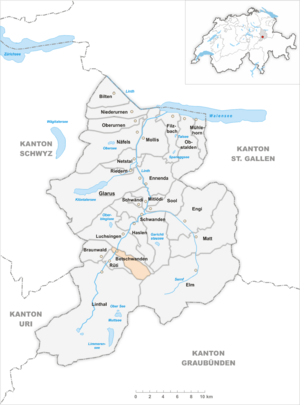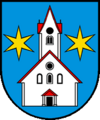Betschwanden facts for kids
Quick facts for kids
Betschwanden
|
||
|---|---|---|
|
Village (and former municipality)
|
||
 |
||
|
||

The former municipal area (2007)
|
||
| Country | Switzerland | |
| Canton | Glarus | |
| Municipality | Glarus Süd | |
| Area | ||
| • Total | 9.74 km2 (3.76 sq mi) | |
| Elevation | 600 m (2,000 ft) | |
| Population
(December 2010)
|
||
| • Total | 182 | |
| • Density | 18.69/km2 (48.40/sq mi) | |
Betschwanden is a small village in the Glarus Süd area of the canton of Glarus in Switzerland. It used to be its own town, but now it's part of a bigger municipality.
Contents
History of Betschwanden
Betschwanden was first mentioned in old writings in the year 1240. Back then, it was called in Beswando.
Early Times and the Church
For many years, until 1395, Betschwanden had to pay special taxes and a part of its harvest (called tithes) to a place called Säckingen Abbey. It was also part of the main church area, or parish, of Glarus.
The village church was built in the 14th century. It had a simple, old style called Romanesque. Over the years, the church was fixed up many times. Walls were added in 1779-80 to protect it from floods. Later, in 1915, new art styles like Art Nouveau and Gothic Revival were added. The church was repaired again in 1975-77 and its outside was rebuilt in 2001.
Changes in Faith
When the Protestant Reformation happened in Glarus, Betschwanden decided to follow the new Protestant faith. In 1528, it joined a new Protestant parish with nearby villages like Braunwald, Hätzingen, Diesbach, and Rüti. Later, in 1942, Braunwald became its own separate parish.
Work and Schools
Until the 1800s, most people in Betschwanden made a living from farming and raising animals in the mountains. A mill, which grinds grain, was built on the Diesbach river in 1778. Today, this old mill is a guest house.
Education became important early on. A church school opened in 1727. A secondary school, for older students, started in 1844.
In 1843, a factory for spinning thread opened. A warehouse was added to it in 1910. This building is now a factory that makes chemicals for textiles. In 1879, a train station opened in the village, connecting Betschwanden to other places.
Joining Glarus Süd
On January 1, 2011, Betschwanden officially became part of the new, larger municipality called Glarus Süd. This means it's no longer a separate town.
Geography of Betschwanden
Betschwanden is located in a valley next to the Linth river. The village sits on the east side of the river. It is about 600 meters (1,968 feet) above sea level.
To the south of Betschwanden is the village of Rüti. To the north is Diesbach. East of the village, you can see the mountain called Kärpf, which is about 2,794 meters (9,167 feet) tall.
The area that used to be Betschwanden's municipality is about 9.7 square kilometers (3.7 square miles). A big part of this land, about 36%, is used for farming. Another 29.8% is covered by forests. Only a small part, 1.1%, has buildings or roads. The rest, about 33.1%, is made up of things like rivers, glaciers, or mountains that can't be used for farming or building.
Getting Around Betschwanden
Betschwanden is on a main road called Hauptstrasse 17. This road goes through the whole Glarus area. It then climbs over a high mountain pass called Klausen Pass into another area called the canton of Uri.
There's also a train line, the Weesen to Linthal railway line, that runs next to the main road and the Linth river. The Klausen Pass is usually only open for cars from June to September. For the rest of the year, the road and railway are the main ways to get to the village.
Betschwanden has its own train stop, called Diesbach-Betschwanden railway station. You can catch the Zürich S-Bahn train service S25 here. This train runs every hour between Linthal and Zürich.
People in Betschwanden
In 2010, Betschwanden had a population of 182 people. About 6.8% of these people were from other countries in 2007. Over the past 10 years, the number of people living here has grown by about 9.1%.
Most people in Betschwanden speak German (93.0%). A very small number of people speak Finnish (0.6%).
People in Switzerland are generally well-educated. In Betschwanden, about 72.7% of adults (aged 25-64) have finished high school or gone on to higher education, like a university or a special college called a Fachhochschule.
The unemployment rate in Betschwanden is about 4.8%. This means that 4.8% of people who want to work can't find a job.
In 2005, there were 5 people working in the primary economic sector. This means they worked in farming or getting raw materials. There were 2 businesses in this area. No one worked in the secondary sector, which includes factories and building. In the tertiary sector, which is about services like shops or hotels, 19 people worked, and there were 7 businesses.
Here's how the population of Betschwanden has changed over time:
| year | population |
|---|---|
| 1692 | 123 |
| 1850 | 254 |
| 1900 | 255 |
| 1950 | 282 |
| 1980 | 132 |
| 2000 | 172 |
Images for kids
See also
 In Spanish: Betschwanden para niños
In Spanish: Betschwanden para niños



